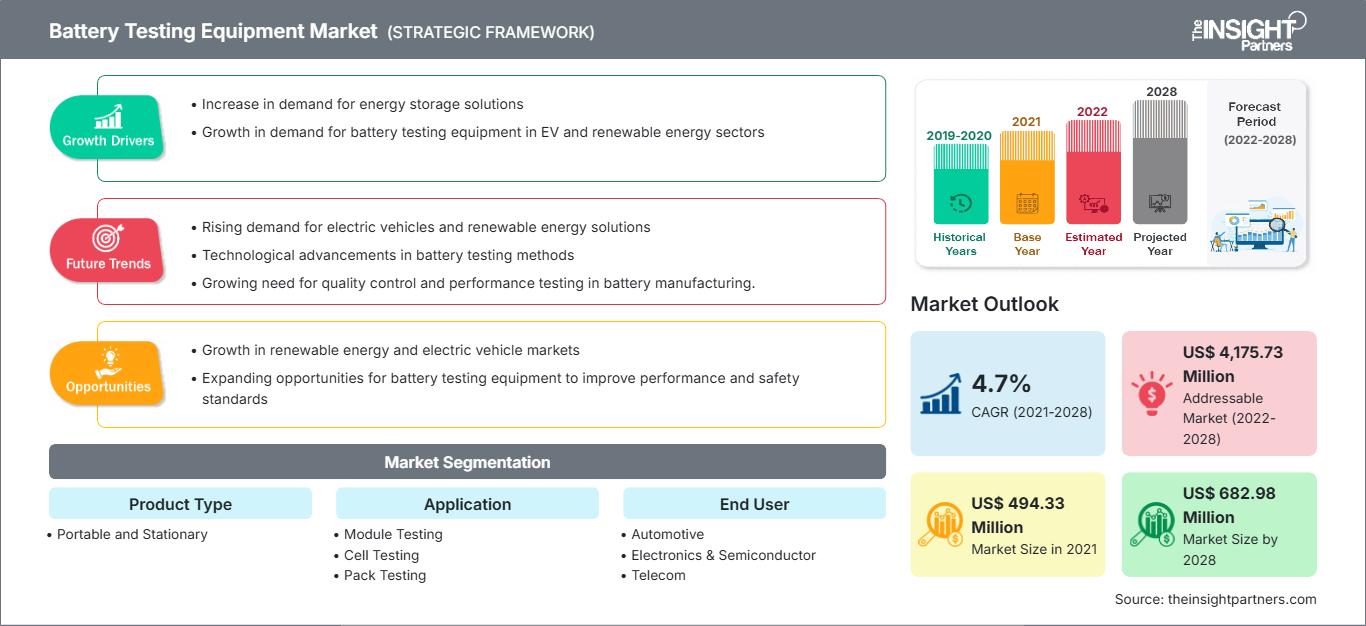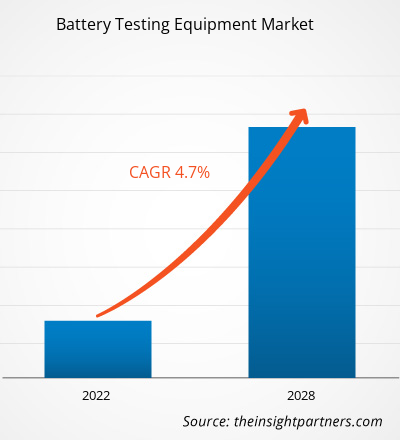Le marché des équipements de test de batteries était évalué à 494,33 millions de dollars américains en 2021 et devrait atteindre 682,98 millions de dollars américains d'ici 2028 ; sa croissance devrait atteindre un TCAC de 4,7 % entre 2021 et 2028.
Des secteurs tels que l'aérospatiale et la défense, l'automobile et la santé investissent massivement dans les technologies de pointe pour renforcer leurs capacités grâce à des machines de pointe et offrir des services améliorés à leurs clients. Des entreprises aux États-Unis, en France, en Suède, au Royaume-Uni et dans d'autres pays développent des équipements de test de batteries avancés pour leurs clients internationaux. L'augmentation des achats de batteries avancées par l'armée américaine soutient également la croissance du marché. De plus, le développement des eVTOL et les initiatives prises par les gouvernements de pays comme l'Allemagne, les Émirats arabes unis et Singapour pour développer les infrastructures de mobilité aérienne urbaine dans ces pays devraient stimuler la croissance du marché des équipements de test de batteries.
L'augmentation des dépenses de défense dans des pays comme les États-Unis, la Chine, l'Inde et d'autres pays devrait stimuler la croissance du marché des équipements de test de batteries dans les années à venir. Les pays en développement, comme l'Inde, la Chine et l'Indonésie, se concentrent sur le renforcement de leurs capacités militaires en raison de la multiplication des conflits transfrontaliers avec leurs pays voisins. L'expansion du secteur manufacturier dans des pays comme la Chine et l'Inde stimule également la croissance du marché des équipements de test de batteries.
Personnalisez ce rapport en fonction de vos besoins
Vous bénéficierez d’une personnalisation sur n’importe quel rapport - gratuitement - y compris des parties de ce rapport, ou une analyse au niveau du pays, un pack de données Excel, ainsi que de profiter d’offres exceptionnelles et de réductions pour les start-ups et les universités
Marché des équipements de test de batteries: Perspectives stratégiques

-
Obtenez les principales tendances clés du marché de ce rapport.Cet échantillon GRATUIT comprendra une analyse de données, allant des tendances du marché aux estimations et prévisions.
Impact de la pandémie de COVID-19 sur la croissance du marché nord-américain des équipements de test de batteries
Les États-Unis sont le pays le plus touché d'Amérique du Nord par la COVID-19. De nombreuses installations de fabrication ont été temporairement fermées ou fonctionnent avec un personnel réduit ; la chaîne d'approvisionnement en composants et pièces est perturbée ; ce sont quelques-uns des problèmes critiques auxquels sont confrontés les fabricants nord-américains.
Comme les États-Unis comptent un plus grand nombre d'équipements de test de batteries, de fabricants de composants et d'industries, l'épidémie a gravement affecté chaque production et génération de revenus. La diminution des effectifs de fabrication a entraîné une diminution de la quantité de production. D'autre part, la disponibilité limitée des matières premières et la fermeture de l'aérospatiale ont également eu un impact sur le marché des équipements de test de batteries aux États-Unis. Cependant, l'augmentation des dépenses militaires du pays et le développement croissant des véhicules électriques par des entreprises comme Tesla devraient offrir des opportunités de croissance aux acteurs du marché des équipements de test de batteries dans un avenir proche.
Aperçu du marché – Marché des équipements de test de batteries
La demande croissante de transport stimule le
En raison de l'augmentation du revenu disponible des populations des économies en développement, comme la Chine, l'Inde, la Corée du Sud et d'autres, la demande de véhicules a augmenté. Selon la Société des constructeurs automobiles indiens (SIAM), les ventes de véhicules de tourisme en Inde ont augmenté de 26,45 % entre septembre 2019 et septembre 2020. Des facteurs tels que l'augmentation des investissements des principaux constructeurs automobiles et les normes gouvernementales favorables concernant la fabrication de véhicules en Asie-Pacifique devraient stimuler la croissance du marché des équipements de test de batteries dans la région. De plus, les initiatives prises par les gouvernements de pays comme le Vietnam pour développer son industrie automobile devraient également stimuler la taille du marché des équipements de test de batteries.
Informations basées sur le type de produit
En fonction du type de produit, le marché des équipements de test de batteries est segmenté en équipements de test de batteries portables et équipements de test de batteries fixes. Le segment des équipements de test de batteries stationnaires était le leader du marché avec une part de marché de 54,1 % en 2020. Les tests de batteries stationnaires sont effectués pour un test de capacité lorsque la batterie est neuve dans le cadre du test d'acceptation, pour un test d'impédance afin d'établir des valeurs de référence pour la batterie, et pour répéter le processus de test ci-dessus dans les 2 ans pour la garantie de la batterie. Le processus de test vérifie l'impédance trimestriellement sur les cellules plomb-acide régulées par soupape (VRLA) et effectue des tests de capacité tous les 25 % de la durée de vie prévue.
Informations basées sur les applications
En fonction de l'application, le marché des équipements de test de batteries est segmenté en tests de modules, tests de cellules et tests de packs. Le segment des tests de cellules était le leader du marché en 2020. Les tests de contrainte des cellules sont effectués pour évaluer la réponse aux contraintes électriques, environnementales et mécaniques, entre autres. Les tests de cellules garantissent une longue durée de vie de la batterie et simulent des profils de test complexes en conditions réelles. De plus, les testeurs de cellules sont conçus pour tester les batteries lithium-ion, les condensateurs électriques à double couche (EDLC) et les condensateurs lithium-ion (LIC). Cela devrait stimuler le marché des équipements de test de batteries.
Sur le plan géographique, le marché des équipements de test de batteries est segmenté en cinq grandes régions : l’Amérique du Nord, l’Europe, l’Asie-Pacifique, le Moyen-Orient et l’Afrique et l’Asie du Sud-Est. En 2020, l’Amérique du Nord détenait la plus grande part de chiffre d’affaires, suivie respectivement par l’Europe et l’Asie-Pacifique. Le marché de la région Asie-Pacifique devrait connaître la croissance la plus rapide, soit 5,8 % entre 2020 et 2028. Arbin Instruments, Century Yuasa Batteries Pty Ltd., Chauvin Arnoux, Chroma Systems Solutions, Inc., DV Power, Extech Instruments, Megger, Midtronics, Inc., Storage Battery Systems, LLC et Xiamen Tmax Battery Equipments Limited figurent parmi les principaux acteurs de l’écosystème présentés lors de cette étude de marché.
Aperçu régional du marché des équipements de test de batteries
Les tendances régionales et les facteurs influençant le marché des équipements de test de batteries tout au long de la période de prévision ont été analysés en détail par les analystes de The Insight Partners. Cette section aborde également les segments de marché et la géographie des équipements de test de batteries en Amérique du Nord, en Europe, en Asie-Pacifique, au Moyen-Orient et en Afrique, ainsi qu'en Amérique du Sud et en Amérique centrale.
Portée du rapport sur le marché des équipements de test de batteries
| Attribut de rapport | Détails |
|---|---|
| Taille du marché en 2021 | US$ 494.33 Million |
| Taille du marché par 2028 | US$ 682.98 Million |
| TCAC mondial (2021 - 2028) | 4.7% |
| Données historiques | 2019-2020 |
| Période de prévision | 2022-2028 |
| Segments couverts |
By Type de produit
|
| Régions et pays couverts |
Amérique du Nord
|
| Leaders du marché et profils d'entreprises clés |
|
Densité des acteurs du marché des équipements de test de batteries : comprendre son impact sur la dynamique commerciale
Le marché des équipements de test de batteries connaît une croissance rapide, portée par une demande croissante des utilisateurs finaux, due à des facteurs tels que l'évolution des préférences des consommateurs, les avancées technologiques et une meilleure connaissance des avantages du produit. Face à cette demande croissante, les entreprises élargissent leur offre, innovent pour répondre aux besoins des consommateurs et capitalisent sur les nouvelles tendances, ce qui alimente la croissance du marché.

- Obtenez le Marché des équipements de test de batteries Aperçu des principaux acteurs clés
- Analyse historique (2 ans), année de base, prévision (7 ans) avec TCAC
- Analyse PEST et SWOT
- Taille du marché Valeur / Volume - Mondial, Régional, Pays
- Industrie et paysage concurrentiel
- Ensemble de données Excel
Rapports récents
Rapports connexes
Témoignages
Raison d'acheter
- Prise de décision éclairée
- Compréhension de la dynamique du marché
- Analyse concurrentielle
- Connaissances clients
- Prévisions de marché
- Atténuation des risques
- Planification stratégique
- Justification des investissements
- Identification des marchés émergents
- Amélioration des stratégies marketing
- Amélioration de l'efficacité opérationnelle
- Alignement sur les tendances réglementaires






















 Obtenez un échantillon gratuit pour - Marché des équipements de test de batteries
Obtenez un échantillon gratuit pour - Marché des équipements de test de batteries